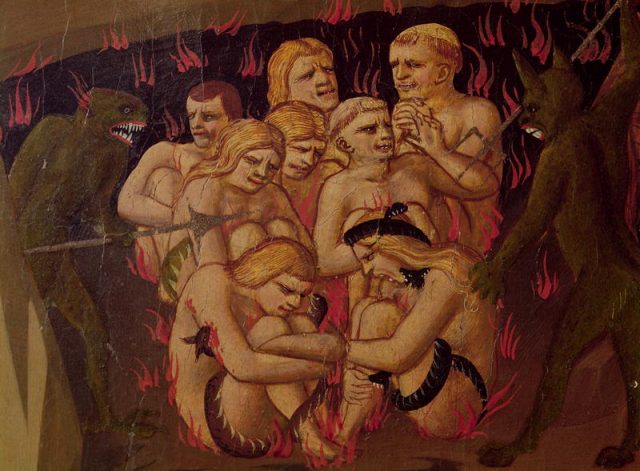
This originally appeared at the Daily Sip, a website dedicated to facing difficult truths in the life of the church with humility, grace and humor
by Charles LaFond
As the light fades from Christmas and the Epiphany season but grows in the natural world around us, we enter now into Lent. The lights of seasonal joy can easily seem to fade into a gloom of sin and repentance when in fact there is nothing gloomy about sin unless one’s image of God is warped into that of an angry, vengeful, cranky God. What can we do to renovate the image of God-in-Lent from the angry God which the church used for centuries to raise money (and rather effectively I might add)? Images of Hell’s torture would inspire gifts to the church as a means by which to buy one‘s way out of judgment, or at least commute one’s sentence to a lesser torture, perhaps not hot tar but just whips in the hands of sinister-looking cherubim, pale and rosy cheeked with pointy teeth. Think Baroque churches…
If that is what some churches have done for centuries – manipulate people with fear of judgment and eternal torture – if that was the plan from 400 AD right through ‘til the 1920’s; might we not have quite a terrible thing from which to recover as a church?
Let’s make this all a metaphor; let’s say, for fun and giggles, that the church were a person, let’s call this person… well, pick a name: Miss Minchin from A Little Princess, Mr. Brocklehurst from Jane Eyre, Mrs. Dodds of the Percy Jackson series, Miss Trunchbull in Roald Dahl’s Matilda, Viola Swamp in the children’s book Miss Nelson is Missing, or Dolores Umbridge from the Harry Potter books,
And let’s say that the congregations of the church were characterized as a child of that person – an innocent child under authority, frightened of sin, evil, demons, disease, poverty and mostly Hell. And let’s say that has happened over the 1600 years in which this church which has been using imagery of torture for sin in hell as a means by which to raise money and control the people – keeping them obedient in fear.
So, in our metaphor, the church is characterized as a person with power and the people in the pews are characterized as a person without power who were preached to about sin and hell-fire as a strategy to raise money or perhaps just as a strategy to keep them terrified. Then, let’s say the money that is raised from the frightened people is used for art which further depicts – in windows, frescoes, painting and sculpture – scenes of judgment, Hell-fire, disease from sin, etc. So if we were to anthropomorphize the arc of the church in history as an angry teacher and the congregations as their pupil or child, then don’t you think that that “child” might need some, well, therapy? Or at least a hug? Or perhaps not. Perhaps that “child” might grow up and leave that parent or teacher and go find a healthier community like a forest or a group of nice people in a book club or a walking group or an art class or a supper club – a new form of community without so much baggage – the way so many millennials are doing, well, now?
As we enter Lent, I am wondering about church history. I am wondering about how the church has used Lent and what karma that has inspired on the planet. And I am wondering if the church (and I) might enter Lent with the same humility as it seeks to inspire in its congregants.
We do not run, arms waving and lips laughing into Lent like we do into Christmas or even Advent’s quiet spiritual sobriety.
I suppose Lent can be a time of grief and guilt if we let it. And I can see how that can be most valuable. I have done some terrible things this past year, and I need to stare at them for a few weeks – seeking forgiveness of others and of myself. And certainly many churches over the millennia had George Herbert or people like him, who were kind and loving pastors.
But I am wondering what am I doing early in Lent to prepare for it to be a productive season, and not simply a navel-gazing shame-based season. What apologies do I need to make? In my Rule of Life I choose two people in Advent and Lent to whom I need to make a face-to-face apology. It is hard work. It takes planning. It takes courage. But it keeps my life as clean as I can muster.
The bright reflection of light in diamonds is not just about the light. Nor is it just about the color refraction. Nor is it about the magic of the cutter’s skills or the setter’s craft or the polisher’s stone. It is also about wiping off the mud and gore which splashes onto the diamond. And onto our lives.
These days before Lent, my work is to prepare for Lent so that it can prepare me for Holy Week and so that it can, in turn prepare me for the Great Vigil and its ramifications.
Each Lent I keep a small bowl of chocolate nearby my meditation station. It reminds me to let go of the drama of Lent and embrace its playfulness and its effectiveness – and God’s. If we want our life to sparkle, examining our diamonds for flaws may be less effective than simply rinsing off the goo which has splashed up from the roads we have travelled.
What if Jesus’ invitation in Lent is to grab a handful of chocolate and then take a very long shower, get a massage, make an apology? But perhaps not wallow in shame. And perhaps stand up to anyone who tells us to.

